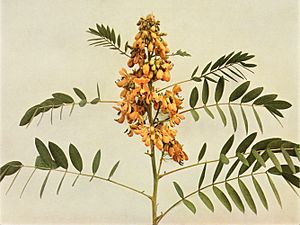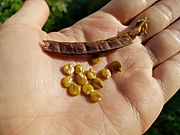Senna hebecarpa facts for kids
Quick facts for kids Senna hebecarpa |
|
|---|---|
 |
|
| Conservation status | |
| Scientific classification | |
| Synonyms | |
|
Cassia hebecarpa Fernald |
American Senna (Senna hebecarpa), also known as Wild Senna, is a type of plant called a legume. Legumes are plants that grow their seeds in pods, like peas or beans. This plant is originally from the eastern parts of North America.
Contents
Where Does American Senna Grow?
You can find American Senna across a wide area in eastern North America. It grows from the Great Lakes region and Maine in the north, all the way south to Georgia. It is commonly found throughout the Eastern United States, including the Appalachian Mountains and the Atlantic Plains.
This plant likes to grow in places that are a bit wet and open, like sunny spots in woodlands. It can also be found in "disturbed areas," which are places where the ground has been moved or changed by people or nature, such as along roadsides or in old fields.
What Does American Senna Look Like?
American Senna is a perennial plant. This means it lives for more than two years, often coming back year after year from the same roots. It usually grows with a few branches.
Its leaves are special because they are "compound leaves." This means each leaf is made up of several smaller leaflets attached to a single stem.
Flowers and Fruit
From July to August, during the summer months in North America, American Senna plants show off their beautiful flowers. These flowers are usually light yellow to orange and grow in clusters.
After the flowers, the plant produces long, flat pods that contain its seeds.
Why Is American Senna Important?
American Senna plays a helpful role in its environment. It is a great plant for certain insects.
Helping Butterflies and Bees
The plant is a "larval host" for the Cloudless Giant Sulphur butterfly (Phoebis sennae). This means the caterpillars of this butterfly eat the leaves of the American Senna plant to grow. The flowers also provide nectar, which is a sweet liquid that adult butterflies drink for energy.
Native bumble bees also love American Senna. They visit the flowers to collect nectar and pollen, which helps them feed their colonies and also helps the plant make new seeds.
Conservation Status
Because of changes in its habitat, American Senna is facing some challenges in certain areas. In some states, it is considered rare or at risk.
- In Massachusetts and New Hampshire, it is listed as endangered. This means there are very few of these plants left in the wild in those states.
- It is considered threatened in Vermont and Connecticut. This means it could become endangered if its numbers continue to drop.
- In Rhode Island, it is listed as "historical," meaning it was once there but is now very rare or possibly gone from the wild in that state.
How Do People Use American Senna?
American Senna is a popular plant for gardening and land projects.
Gardening and Landscaping
People often grow American Senna as an ornamental plant. This means it's grown for its beauty. It's a great choice for:
- wildflower gardens
- wildlife gardens, where it helps attract butterflies and bees
- natural landscaping projects, which try to make gardens look more like natural areas
- habitat restoration projects, where people try to bring back native plants to help local wildlife
Traditional Uses by Native Americans
Native American tribes have used American Senna for many generations. They understood the plant's properties and used it for various purposes.
- The Cherokee people used a special liquid made from the plant, called an infusion. They used it for things like cramps, heart trouble, and fevers. They also gave it to children and adults to help with digestion. They even used a special mix for fainting spells and for lung issues.
- The Iroquois people used the plant to help with worms and as a laxative, which helps the body clear out waste.



